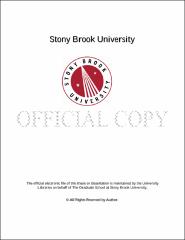| dc.identifier.uri | http://hdl.handle.net/11401/76701 | |
| dc.description.sponsorship | This work is sponsored by the Stony Brook University Graduate School in compliance with the requirements for completion of degree. | en_US |
| dc.format | Monograph | |
| dc.format.medium | Electronic Resource | en_US |
| dc.language.iso | en_US | |
| dc.publisher | The Graduate School, Stony Brook University: Stony Brook, NY. | |
| dc.type | Dissertation | |
| dcterms.abstract | Direct photons provide a tool to study the different stages of a heavy ion collision, especially the formation of the quark-gluon-plasma (QGP), without being influenced by the strong reaction and hadronization processes. The yield of direct photons can be determined from the inclusive photon yield and the photon yield from hadronic decays. At low p<sub>T</sub>, where a significant fraction of direct photon is expected to come from the thermalized medium of deconfined quarks and gluons and interacting hadrons, the measurement is very challenging. These so-called thermal photons carry information about the initial temperature of the medium. We present a new analysis technique that was developed to improve direct photon production measurement in the low and medium p<sub>T</sub> range. The technique was applied to the PHENIX Run4 Au+Au sqrt(s<sub>NN</sub>)=200GeV/c collisions dataset. It uses strict particle identification (PID) in the Electromagnetic Calorimeter (EMCal) and a charged particle veto to extract a clean photon signal. These photons are then tagged with EMCal photon candidates with loose PID cuts, which can be reconstructed with high efficiency, to determine the fraction of photons originating from neutral pion decays. Most systematic uncertainties and detector effects cancel in this method. The results are compared with recent PHENIX direct photon measurement through external conversion method and theoretical calculation predicting thermal photon production. | |
| dcterms.available | 2017-09-20T16:51:01Z | |
| dcterms.contributor | Kuo, Thomas | en_US |
| dcterms.contributor | Drees, Axel | en_US |
| dcterms.contributor | McCarthy, Robert | en_US |
| dcterms.contributor | David, Gabor. | en_US |
| dcterms.creator | Gong, Haijiang | |
| dcterms.dateAccepted | 2017-09-20T16:51:01Z | |
| dcterms.dateSubmitted | 2017-09-20T16:51:01Z | |
| dcterms.description | Department of Physics. | en_US |
| dcterms.extent | 145 pg. | en_US |
| dcterms.format | Monograph | |
| dcterms.format | Application/PDF | en_US |
| dcterms.identifier | http://hdl.handle.net/11401/76701 | |
| dcterms.issued | 2014-12-01 | |
| dcterms.language | en_US | |
| dcterms.provenance | Made available in DSpace on 2017-09-20T16:51:01Z (GMT). No. of bitstreams: 1
Gong_grad.sunysb_0771E_11806.pdf: 5485644 bytes, checksum: f22663b1a72e5b7faabbe9db06cc37a7 (MD5)
Previous issue date: 1 | en |
| dcterms.publisher | The Graduate School, Stony Brook University: Stony Brook, NY. | |
| dcterms.subject | Direct Photon, Gold Collisions, PHENIX, Photon, RHIC, Thermal Photon | |
| dcterms.subject | Physics | |
| dcterms.title | Measurement of Direct Photons in Ultra-Relativistic Au+Au Collisions | |
| dcterms.type | Dissertation | |

